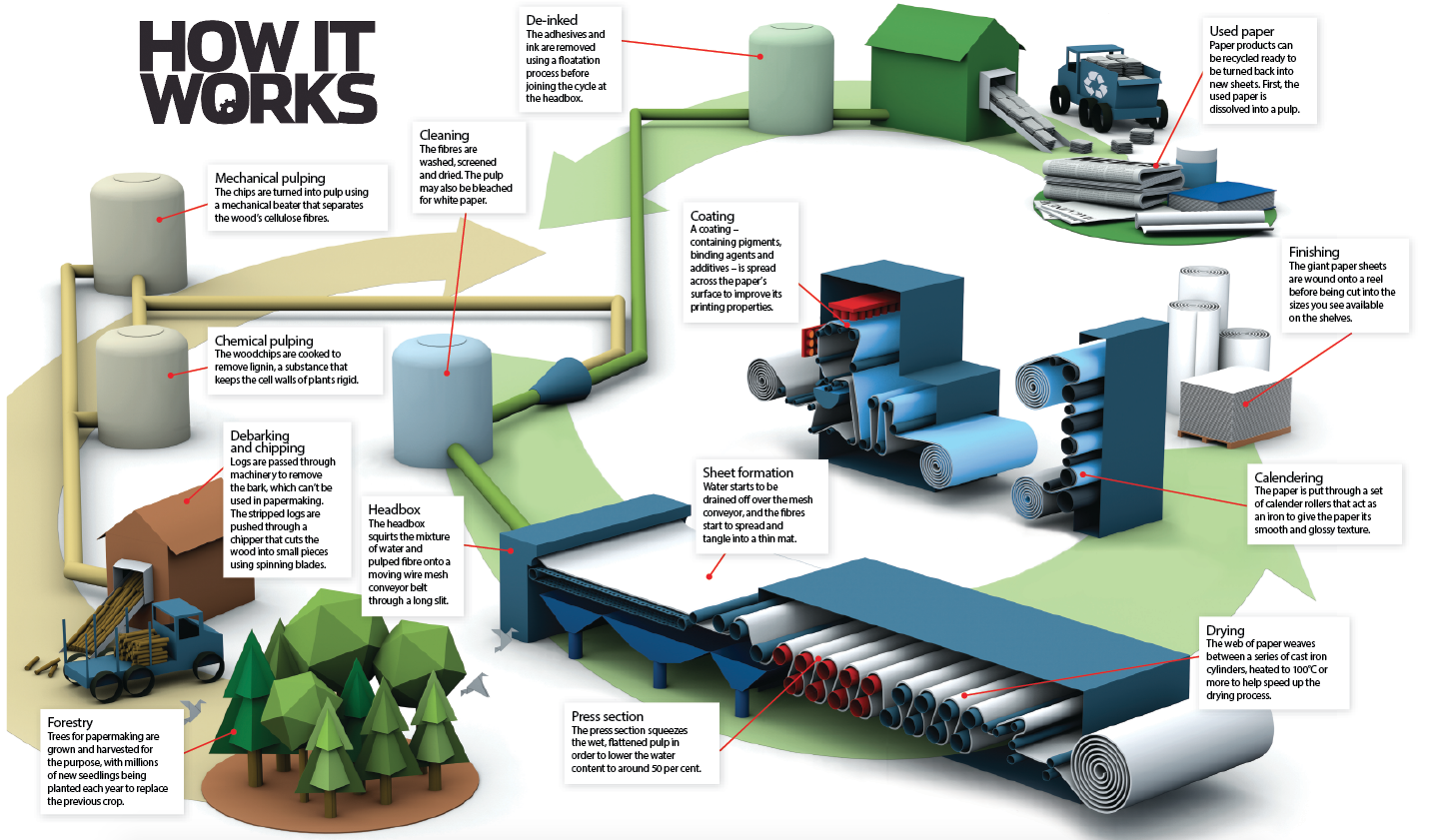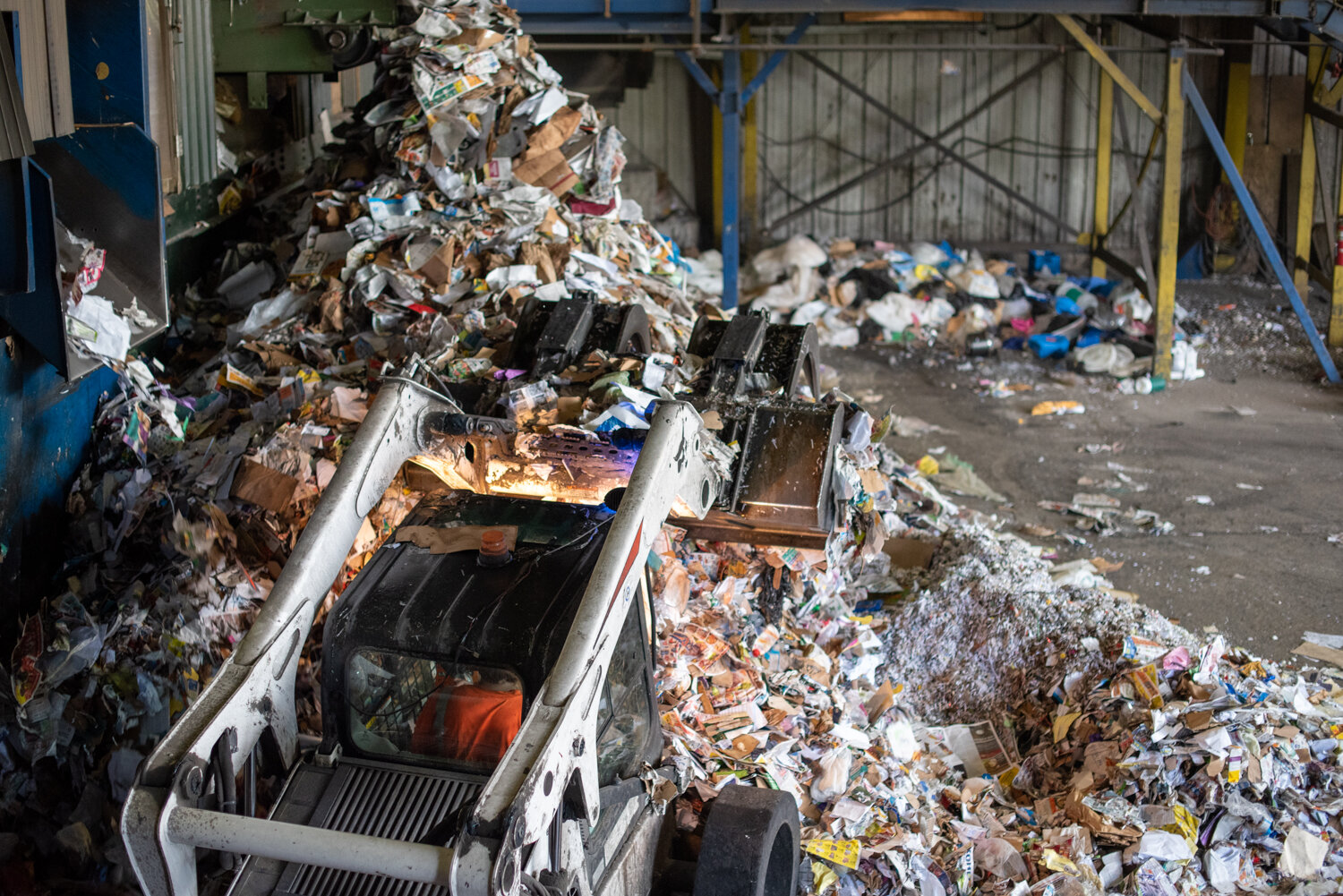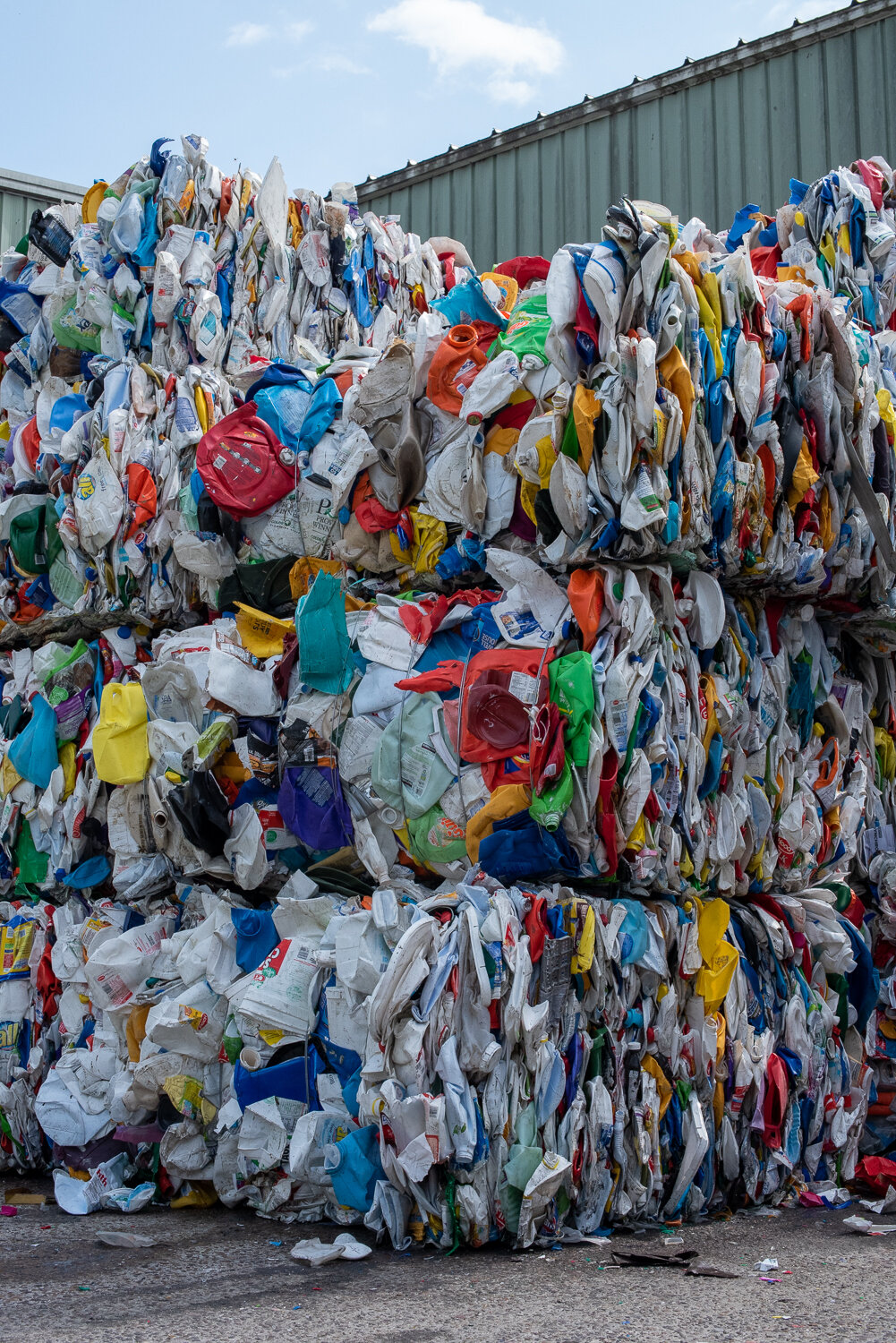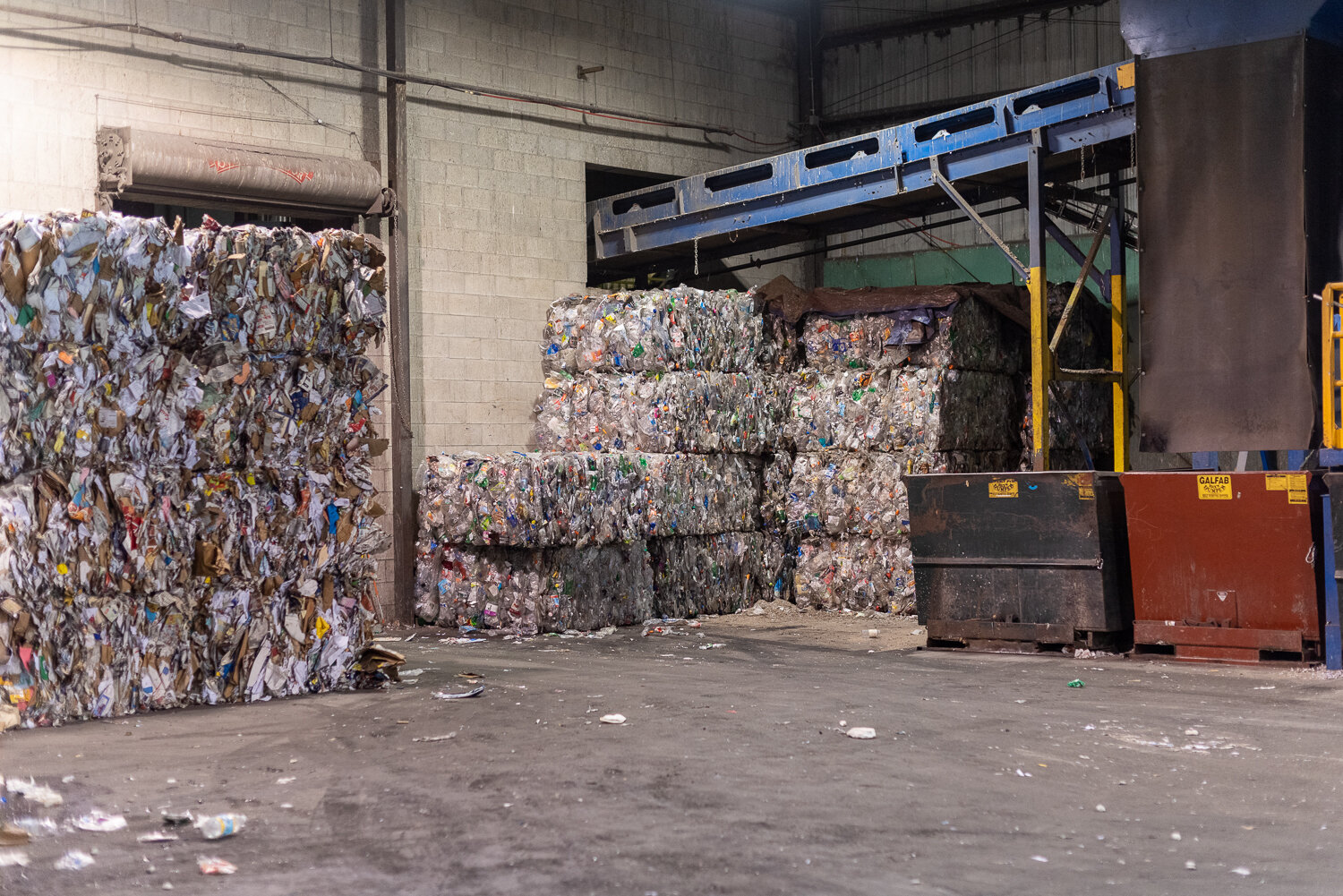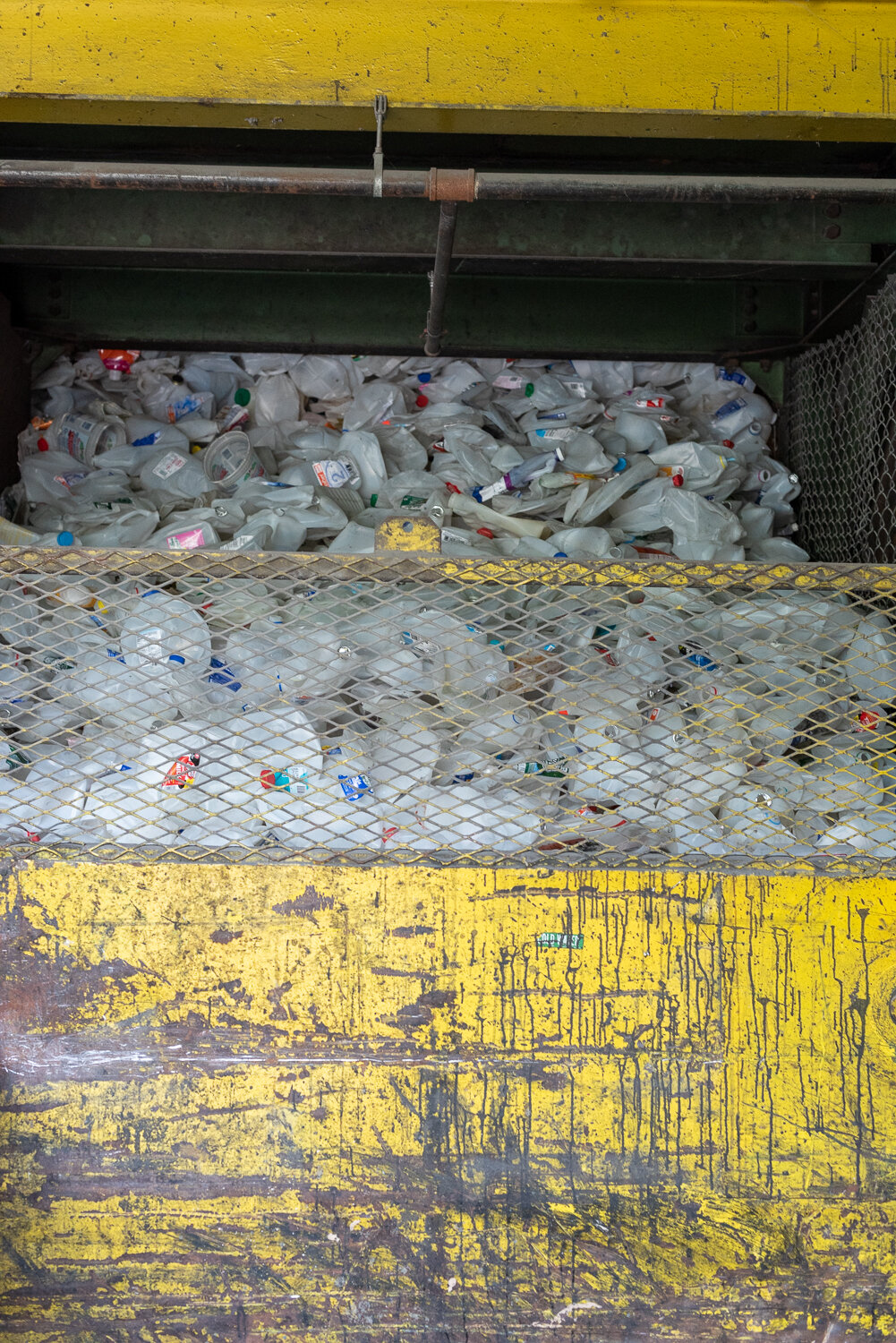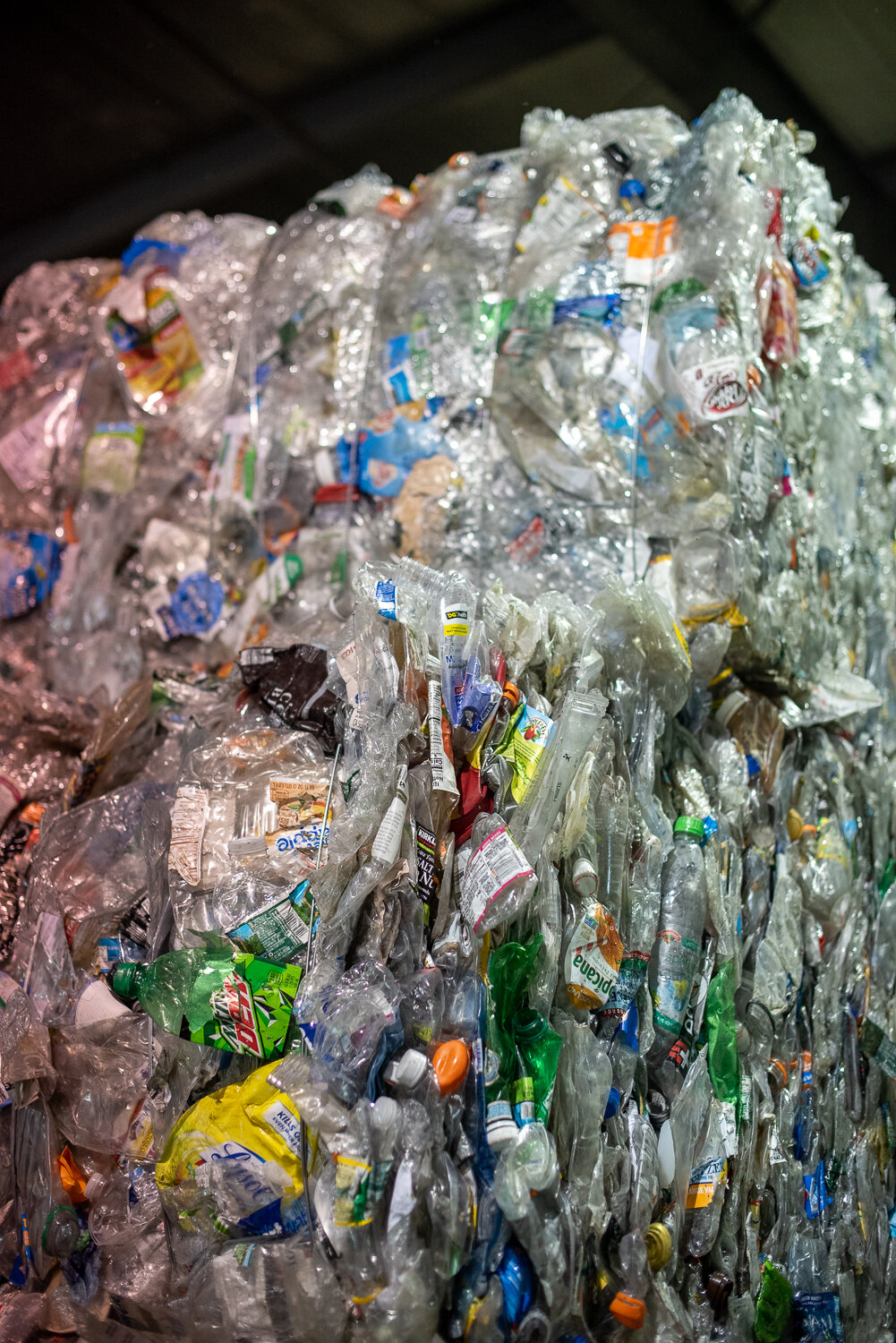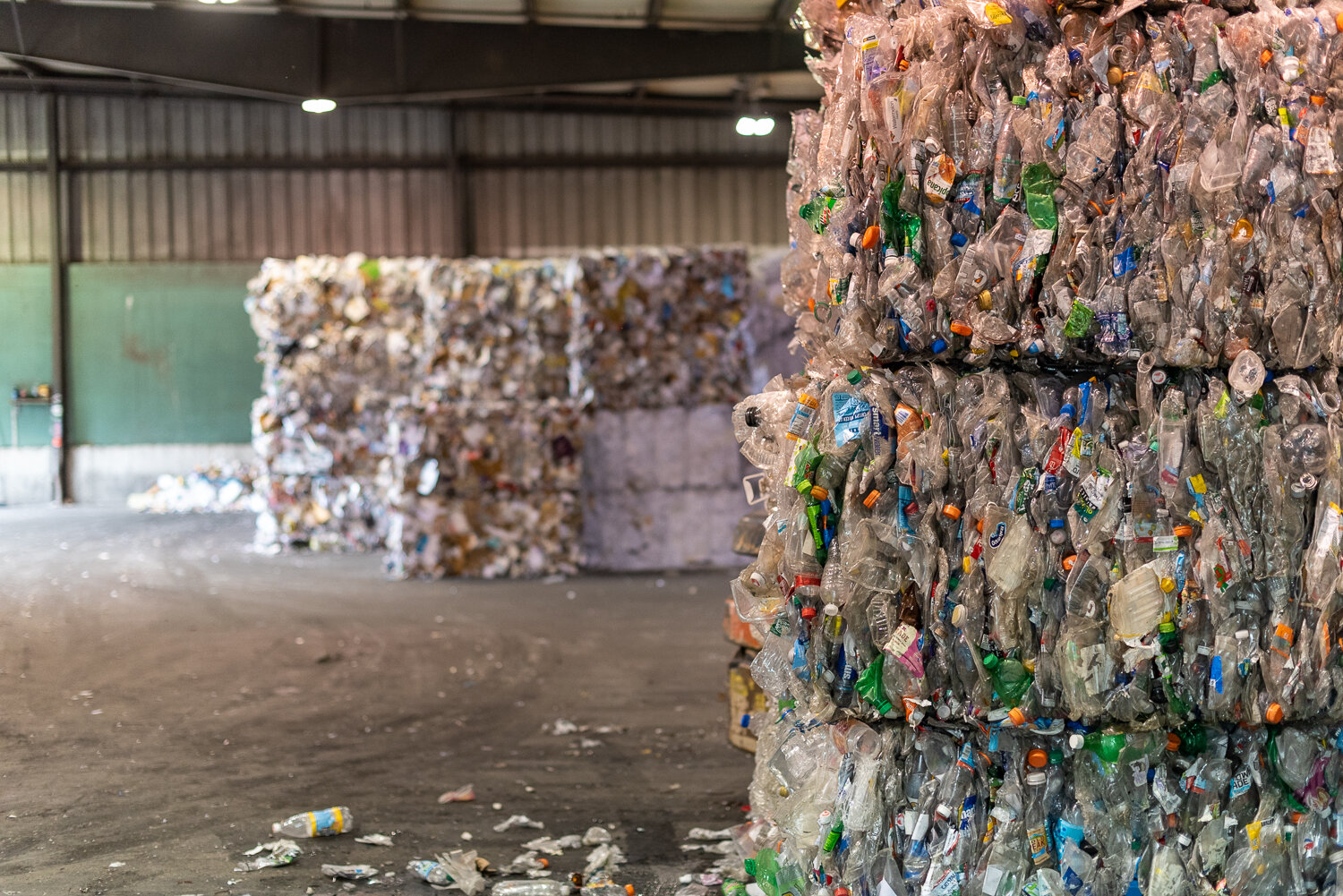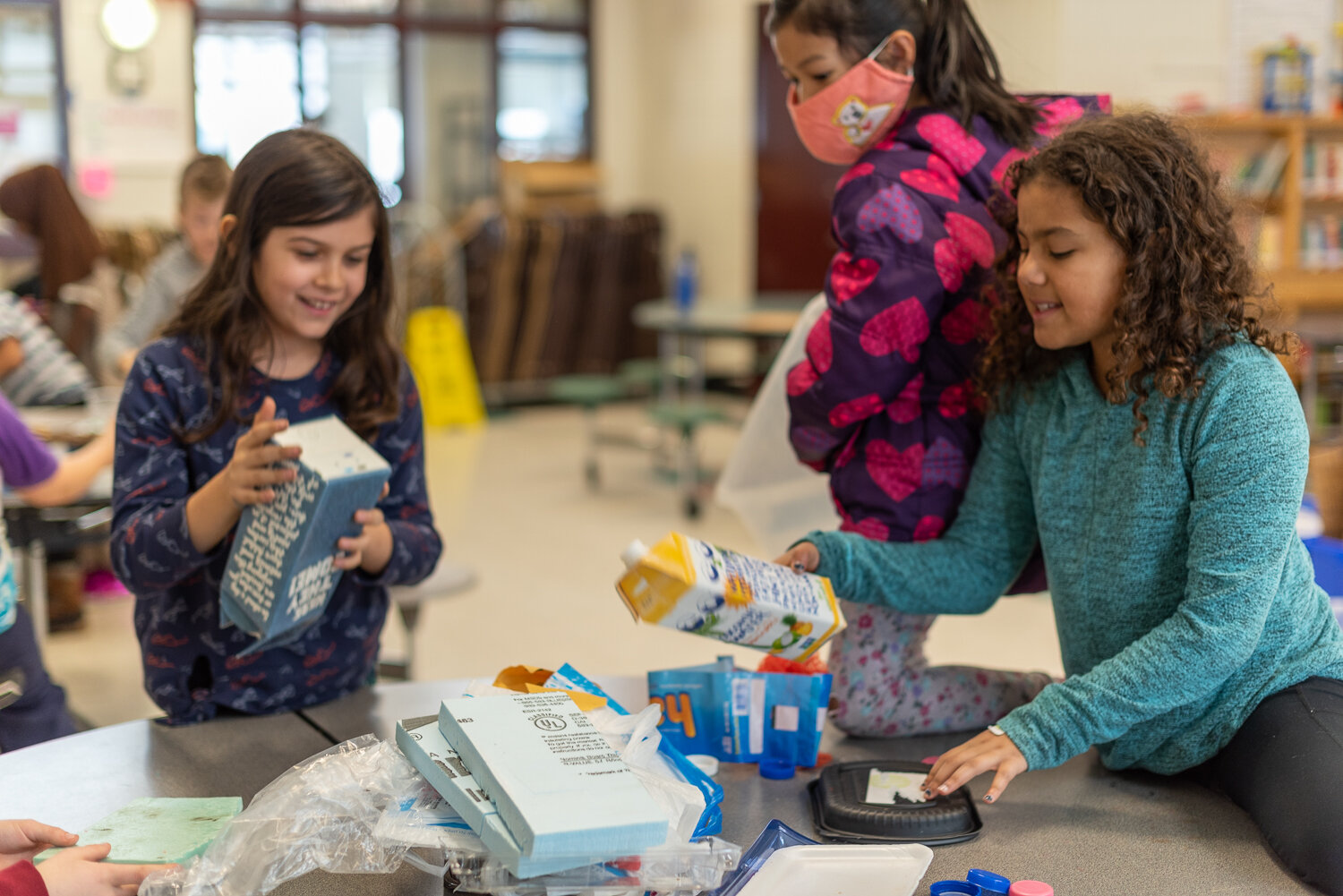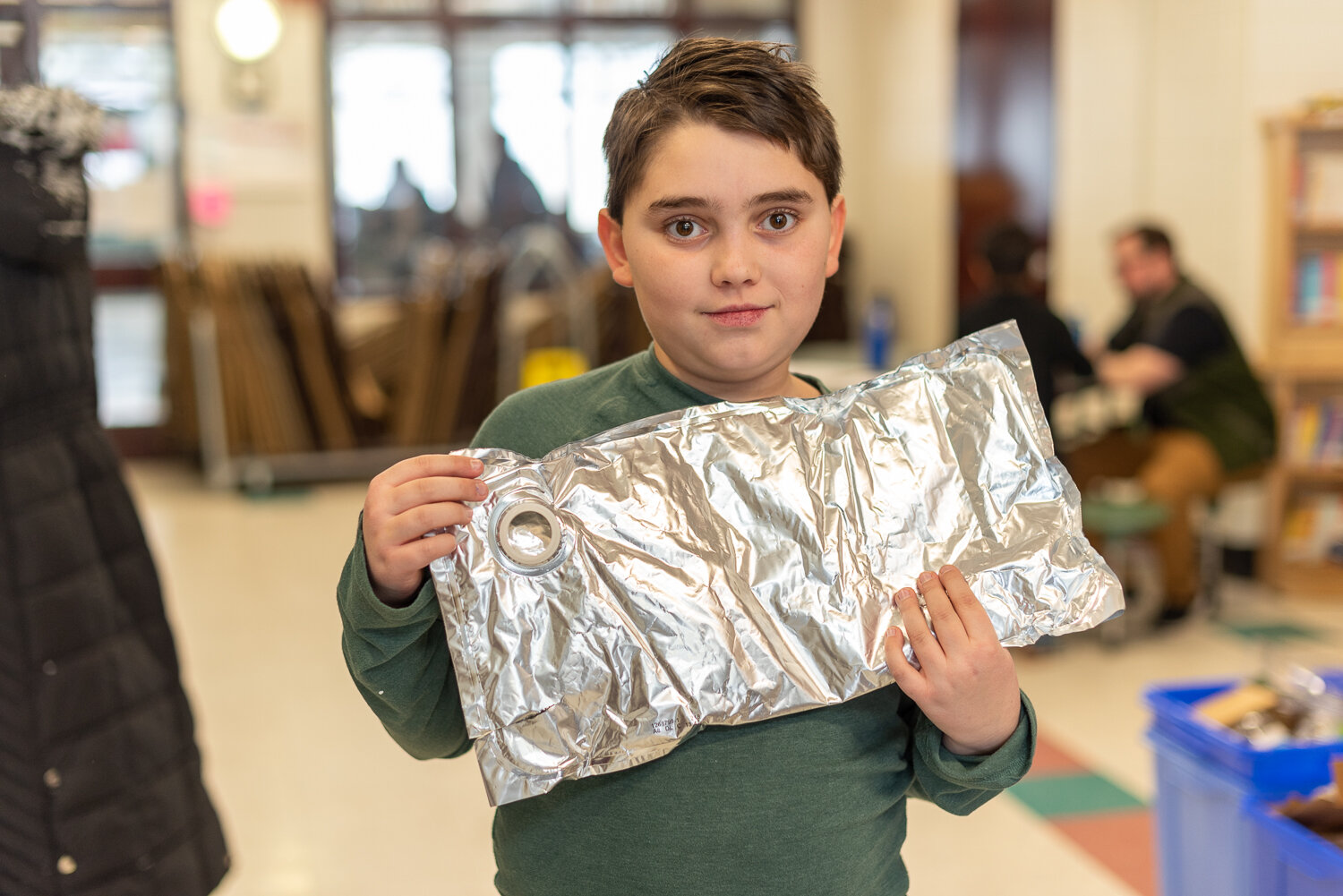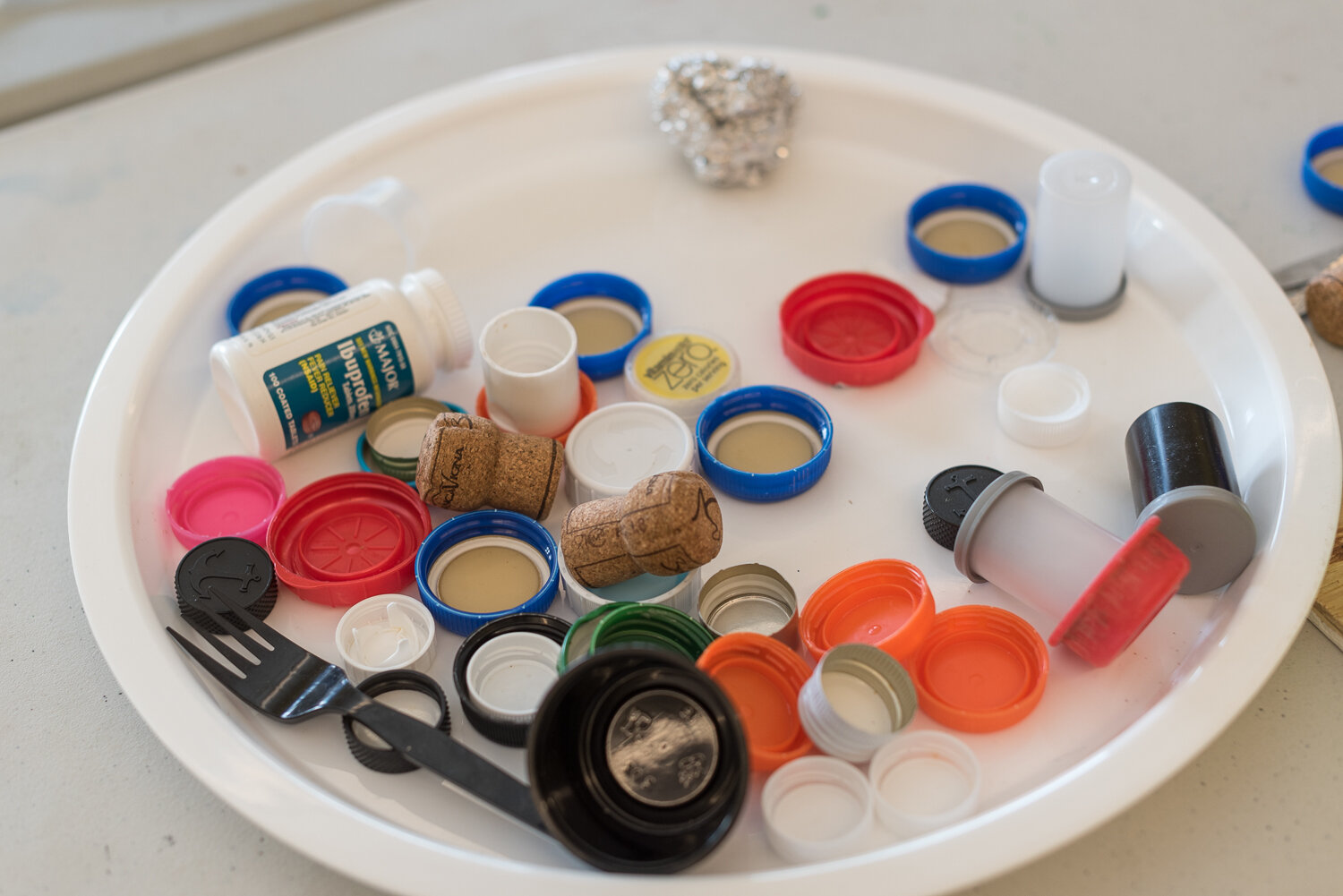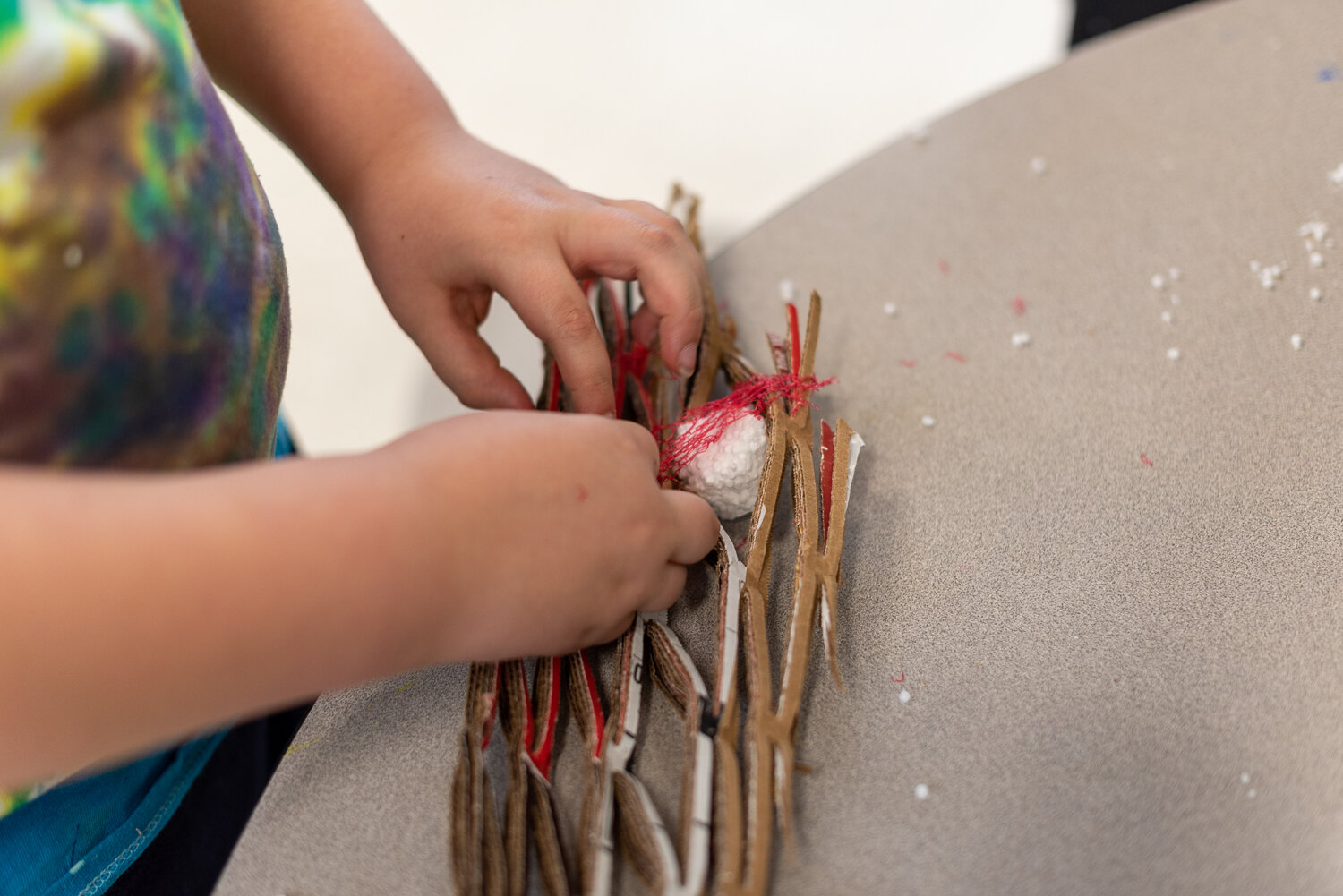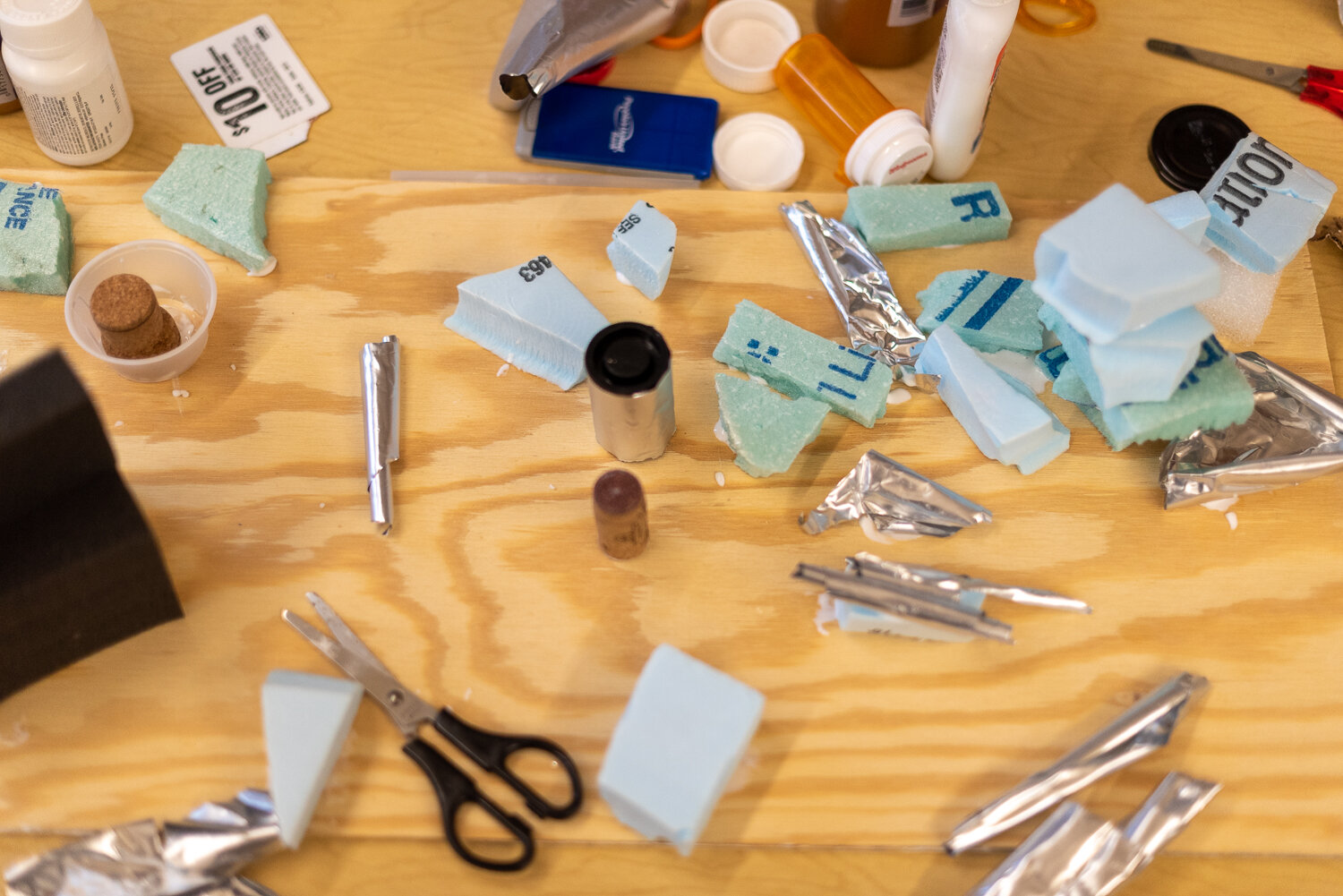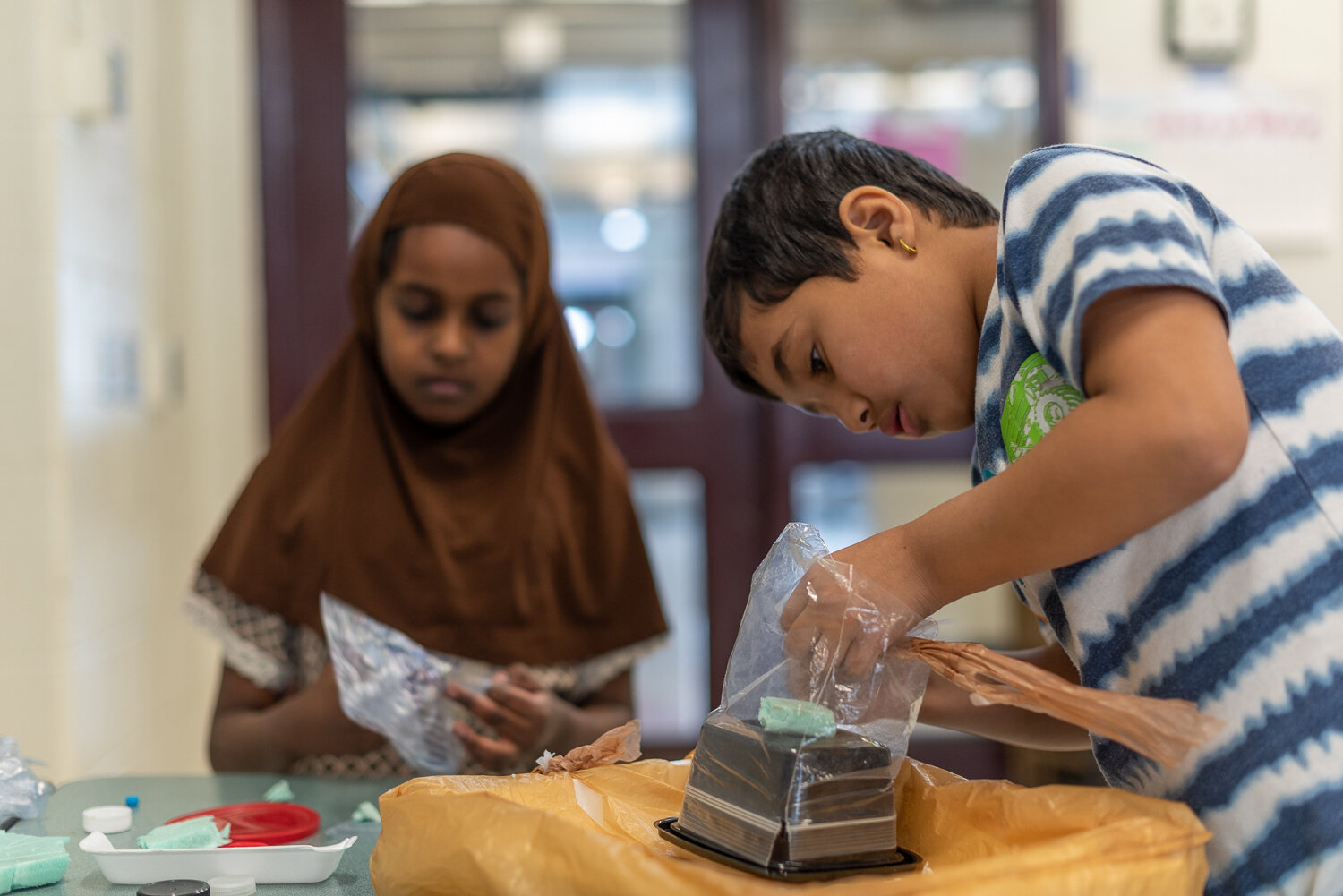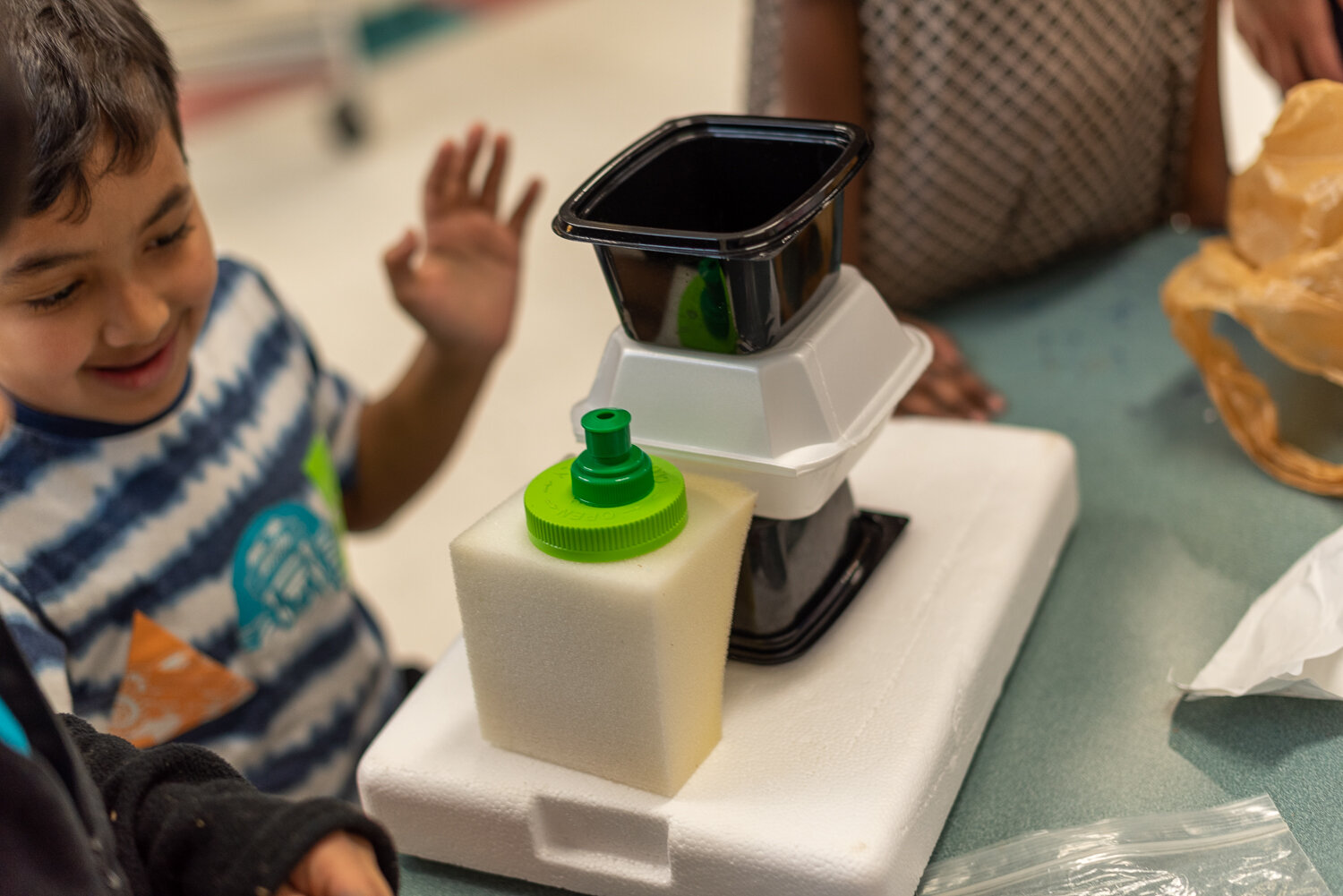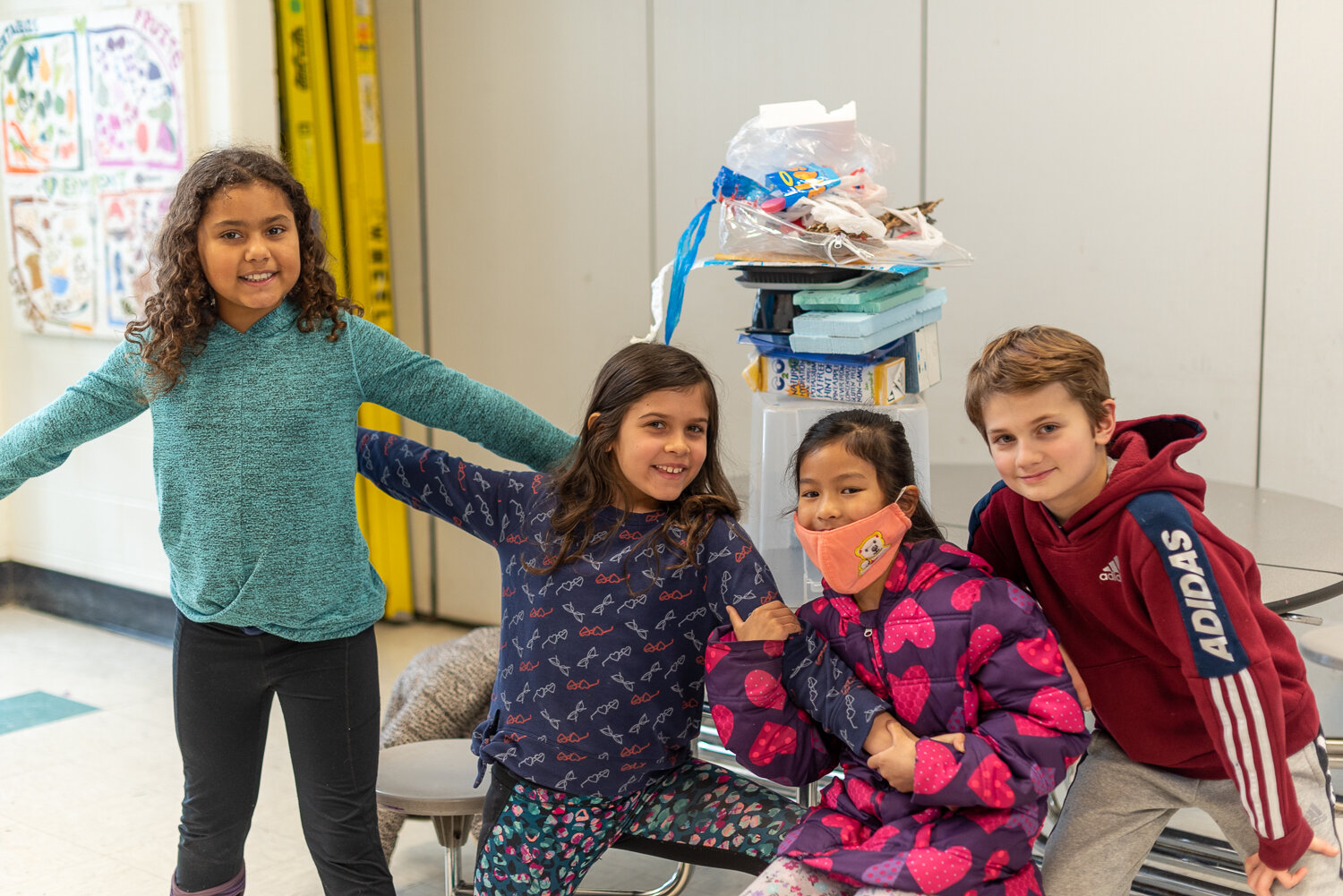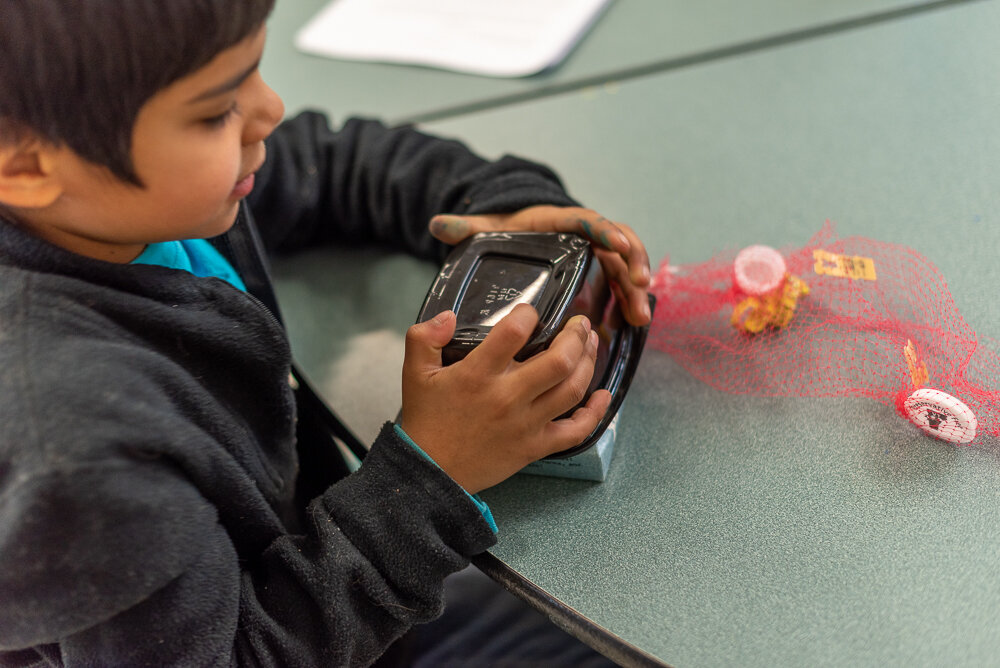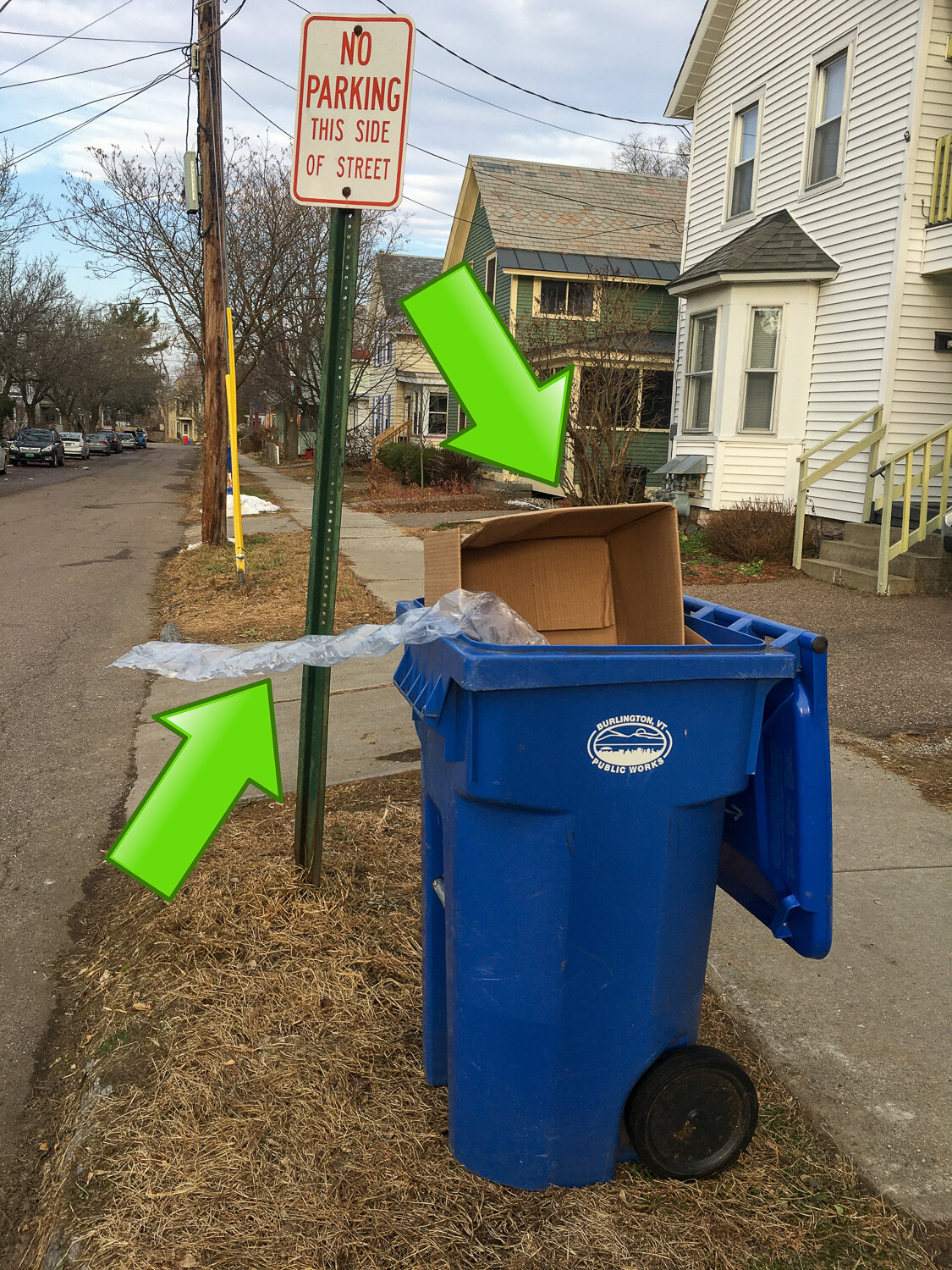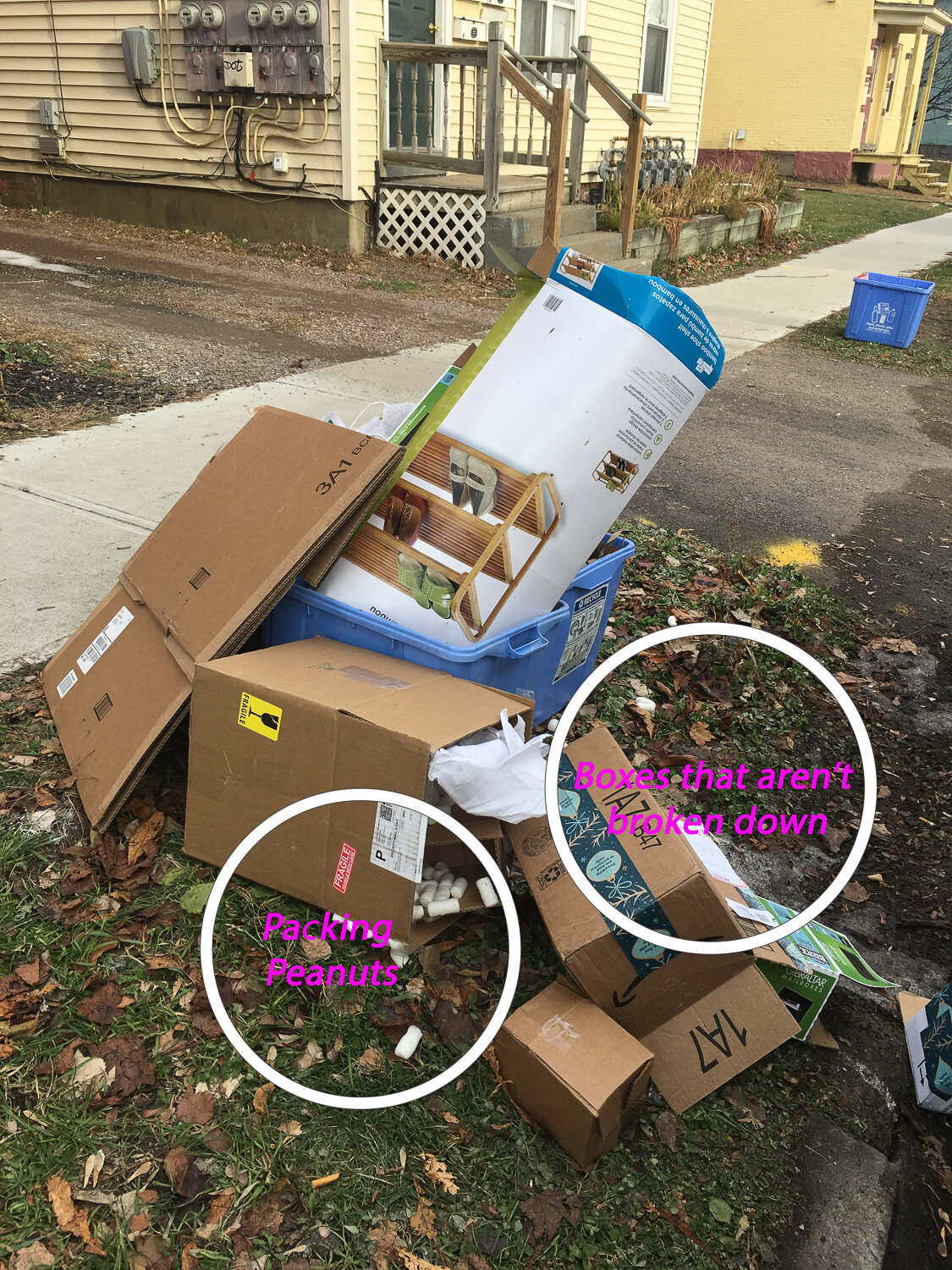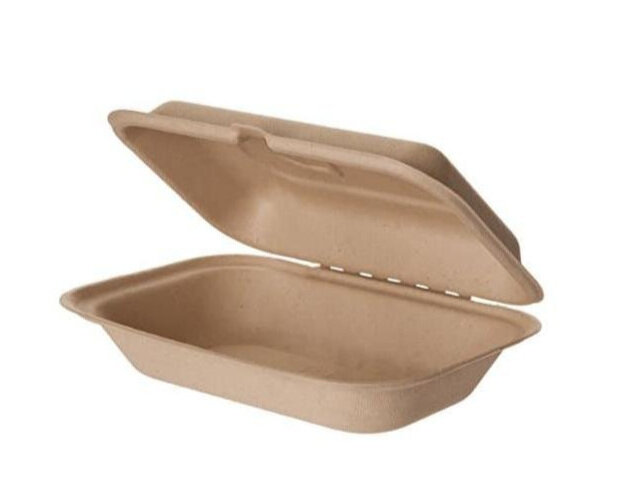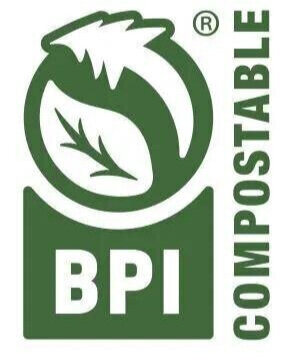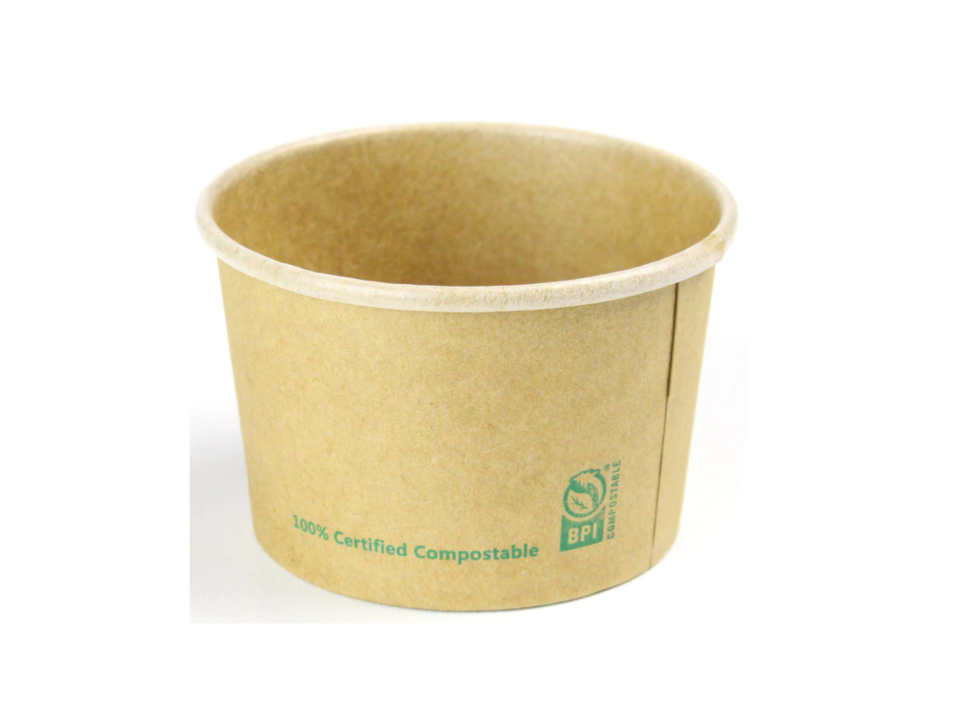What a year…
This project started in January of 2020 where we sat close to participants and riffled through discarded plastic together. In late December 2020 the mural was installed for the third and final time in an empty building, alone and masked we looked back on out Creative ReUse year.
Our last school residency in February was a bit tense with students washing hands before and after every activity but no one actually knew what was coming. We are incredibly lucky to have met with most participants in person before the stay at home order. Thanks to some timely grants and artists relief funding, we shifted gears and created this website to keep the project going and quite honestly to keep ourselves going. Finding creativity was hard and we needed something to work on amidst the stress of an emerging global pandemic. When schools closed and we knew that many students would not have any access to art supplies, we wanted to share creative projects that could be done at home with the things in your recycling bin. The switch from in person teaching to making videos alone at home was a shift to say the least.
The next time we saw each other in person, we worked outside with masks on, constantly dancing around each other to keep our distance. To follow the trend of the year, the plan for this project kept morphing and changing. The mural was displayed outside for most of the summer and fall around Burlington. When at first we could not find a space to install, Alissa’s own driveway became an outdoor gallery. Late in the summer the mural moved outside of Echo, looking at the same view that inspired us in the first place.
Thank you to all our partners and the participants who helped us on this journey. It was truly a community project whether we were together in person, emailing back and forth, learning something new or viewing art from afar. Creative community engagement touches us all and we are grateful for the experience.
The Making of the Creative ReUse Mural
Community art in the making! In Burlington, VT participants from the Champlain Senior Center, Integrated Arts Academy, Sustainability Academy and The Janet S Munt Family Room helped create a community mural using “wishful recycling” items.
Wishful Recycling Community Mural
Our mural is now located at ECHO’s Hoehl Park on the waterfront in Burlington, VT! Old North End community members of all ages, from preschool students to seniors, helped us create a community mural using “wishful recycling” items to build awareness of the challenges of recycling. Participants from the Champlain Senior Center, Integrated Arts Academy, Sustainability Academy and The Janet S Munt Family Room sorted through (clean) non-recyclable items and created the individual tiles that make up the larger mural.
View from the mural overlooking Lake Champlain and the Adirondack mountains at ECHO’s Hoehl Park on the waterfront in Burlington, VT.
The mural highlights the wishful thinking so many of us do when we’re putting items in the recycling bin. “Maybe this goes here? Oh, they’ll sort it out at the plant.” Such items include black plastic, soy and almond milk cartons or flimsy plastic bags and packing materials. These items do not belong in our recycling bins.
One of the intentions behind the mural is to inspire us to remember that if many individuals do their part to reduce waste and think carefully about what we are putting into recycling, we can have a positive impact on our local waste stream, which in turn can have a meaningful impact on climate change.
Black Plastic Ban
Most often, we see black plastic in the form of coffee cup lids, to go containers and food trays. Generally, we will put these items in our blue bins when we’re done with them, but did you know that black plastic is not accepted at our local Materials Recovery Facility (MRF)? Most black plastic has a recycling symbol on it, which makes it confusing, but in Vermont if we put black plastic in our blue bins, it will be sent to the landfill. Why is that?
Materials that have been separated from recyclables and will be sent to a landfill.
Essentially, black plastic can only be made into more black plastic, which is a color of plastic that doesn’t have a strong market, so it doesn’t have a good resale value. When black plastic is mixed in with other colors of plastic, it lowers the versatility of the color palate for the recycled plastic. So, most MRFs will sort out black plastic from their bales because leaving the black plastic in will lower the overall value of the bale. According to our local waste district, the CSWD, it lowers the value because “companies that buy our recyclables haven’t figured out a dependable way to sort {black plastic}. Most of them use infrared, optical sorting devices to separate different types of plastics that arrive in the same bale. Because black plastic absorbs the infrared light instead of bouncing it back to the sensor, it’s really hard and more expensive for them to deal with.” Since the resale value of black plastic is so low, it’s not worth it economically for companies to develop new sorting technologies.
Bales of plastic at the MRF in Williston, VT.
Not only is black plastic not saleable as a recyclable material, according to Kanika Ghandi at VPIRG black plastic also “poses a serious health concern.” Unfortunately, “because black plastic is generally not recycled, these plastics and their chemical additives end up in our landfills or on the side of the road. The toxic chemicals can then find their way into the environment and could end up in our drinking water and food that we eat.” So when you can, avoid buying black plastic. Forgo the black coffee cup lid and bring your own containers when possible. If you do end up with black plastic, be sure to reuse it or throw it away. It doesn’t belong in the blue bin.
Green Up Vermont
The first Green Up Day is launched statewide by Governor Deane Davis on April 18, 1970. The Interstate Highways close from 9 to 12 for litter pick up by volunteers. Source: Green Up Vermont
Each year, Vermonters across the state gather for Green Up Day, a day dedicated to removing litter from our streets, roads and waterways. It’s an excellent opportunity to meet your neighbors and connect with others while achieving a common goal. This year is Green Up Day’s 50th Anniversary and on Saturday, May 30th, you can help celebrate! Check out their website to get all the up to date information. Our garbage scavenger hunt and garbage grid challenge are designed to help you have fun while doing good. Send us a few photos when you’re done!
Kids Week in BTV
This week, we’re celebrating a week of fun, free activities for kids in Burlington. Normally, Kids Day is held on a Saturday in early May, but this year because of COVID19 we are joining with our friends at Burlington Parks, Recreation and Waterfront to celebrate all week long!
You can participate in Kids Week by cleaning up in your neighborhood parks and creating a garbage grid from your favorite finds. In less than an hour, you can make a big impact in beautifying the space around you. Plus it’s great practice for Green Up Day when Vermonters across the state will be picking up garbage on May 30.
The theme of Kids Week is sustainability and one of our fellow partners, Marina McCoy at Waste Free Earth has created a video and guide to help us learn how we can compost, recycle and reduce our waste in the Chittenden County area. In the video, Marina, Zero-Waste and Recycling Expert, walks us through the steps of how we all can decrease our waste and help out the planet.
Be sure to download the free packet that complements the video for you to keep as a reference.
Where Does Paper Come From?
Paper is essentially created through a two-part process:
Cellulose fibers are extracted from a variety of sources and converted to pulp.
Pulp is combined with water and placed on a paper making machine where it is flattened, dried, and cut into sheets and rolls.
The “cellulose fibers” mostly come from trees or recycled paper.
Image Source: How It Works Daily
We use a staggering amount of trees to make paper and other wood-related products, but we also know that trees are amazing! We want to save as many of them as we can for us and future generations to enjoy. They clean the air, contribute to biodiversity, cool our earth and so much more!
So what can we do to protect more trees from being made into paper? First, we can manufacture more paper from recycled paper pulp and less from virgin paper pulp, which requires trees to be cut down, stripped of their bark and then made into wood chips that can be boiled down and made into pulp. That means, when you are finished with the paper you are using, be sure to put it in the blue bin so that it can then be recycled and made into paper once more.
In Vermont, our recycling system is “zero sort”, which means, everything we put in our blue bins must be sorted out once it arrives on the warehouse floor at our Materials Recovery Facility (MRF) in Williston, VT. This is why it is especially important to only put in clean items that are accepted at the facility.
If you have small scraps of paper, or shredded paper, you will need to put it in a clear plastic bag so that they can pull off the bags once they arrive at the MRF. Otherwise, those tiny bits of paper will blow all over the facility and may not be recycled. Shredded paper is the only material you should put in a clear plastic bag. Everything else has to be loose.
Additionally, if you need to buy paper, we learned from Maryruth Belsey Priebe to look for paper that is:
Made with a minimum of 50% post-consumer recycled content.
When 100% recycled paper is not available, look for paper that has (Forest Stewardship Council) FSC-Certified virgin fibers.
Look for unbleached paper by seeking out paper that is either marked processed chlorine-free (PCF), which is preferred over totally chlorine-free (TCF). Elemental chlorine-free is okay, but not a great option.
Look at where the paper was manufactured to ensure your eco-paper purchase has the shortest transportation distance from your location, thus decreasing greenhouse gas admitted.
For this week’s activity and challenge, learn how to make your own envelope and greeting card with paper scraps from past projects and your blue bin.
In appreciation of trees, below is the orginal 1973 animation by Shel Silverstein, The Giving Tree.
The Beginnings of Aluminum: Bauxite Mining
Did you know that aluminum is the second most used metal after steel and that it can be recycled infinitely and not lose its quality? In fact, “because of this efficiency, more than two-thirds of all the aluminum ever produced is still in use today.” The more we commit to recycling aluminum and purchasing recycled aluminum products, the more we can work together to prevent the need to extract bauxite from the earth to create new aluminum.
“Bauxite, a complicated mixture of compounds consisting of aluminum, oxygen, and other elements, is the primary commercial source for aluminum.”
Aerial view of a bauxite mine by Luis Castaneda/Getty Images. “It requires 4 tons of ore to create 1 ton of aluminum.”
“ Large reserves of bauxite are found in Australia, Brazil, Guinea, Jamaica, Russia, and the United States. ”
Can you identify the countries that hold the largest reserves of bauxite?
To create a bauxite mine, the land must be cleared, which means all vegetation, top soil and trees need to removed so that access roads can be made for the miners and equipment to remove the bauxite from the earth. During the mining process, “harmful substances are emitted.” In addition, indigenous people, those who are native to the area, are often negatively effected by mining. Although creating mines does create jobs, the results of pollution and waste are detrimental to those living closest to the land. It takes many decades after the ore has been extracted for the land to be reclaimed and restored, which doesn’t always happen.
“Recycling aluminum prevents the need to mine for ore to create new aluminum.” So the next time you finish drinking from an aluminum can, be sure to rinse it out and put it in your blue bin. Tin foil, pie plates and pans can all be recycled if they are clean, dry and larger than 2 inches. Clean and save your bits of foil to make these fun figures. Once you’ve saved enough, ball up your foil into a baseball sized piece and place it in the blue bin.
For more resources on the story of aluminum and the benefits of recycling aluminum, check out these articles that were used as sources for this post:
IVAM: Aluminum and Sustainability
What One Thing Should I Recycle? Aluminum!
Cardboard Box Challenge
Thanks to our Creative ReUse friends in MD, PA and VT for sharing their work with us. We’d love to see more, so send us your photos of mazes, portraits, swords and shields! The ideas are endless. In the age of social distancing and stay at home orders, simply making signs to encourage your neighbors can be a great way to better your community and reuse resources you already have at home. For more inspiration, check out Caine’s Arcade by Nirvan Mullick. At the age of 9, Caine made an entire arcade gallery out of cardboard boxes.
Plastic
We firmly believe we need positive outlets to reimagine the future during this crisis while also recognizing the fact that “Plastic packaging accounts for nearly half of all plastic waste globally, and much of it is thrown away within just a few minutes of its first use… When discarded in landfills or in the environment, plastic can take up to a thousand years to decompose” (Erik Solheim, 2018 UN Report). As restaurants move to take out only, grocery stores discourage customers from bringing their own bags, and we utilize necessary disposable plastic protective gear, our consumption of single use plastic is growing. How do we adapt and manage waste effectively in the face of these challenges?
In Vermont, we are continuing to recycle. However, John Casella , Chairman and CEO of Casella Waste Systems, has asked for flexibility in waste management during this time. “Casella, as well as other waste haulers in the state, have proactively asked Gov. Phil Scott and the Legislature to grant the secretary of the Agency of Natural Resources the authority to commingle recycling and solid waste during states of emergency.” In response, CSWD has testified in favor of continuing to recycle as much as possible and local organizations such as VPIRG have put out a call to action: Tell VT Officials to Keep Recycling in Vermont.
We have come to find that there aren’t any easy answers. How COVID 19 will change our ways of managing waste has yet to be seen. The recycling system is complex, but through this project, we hope to shed some light on the process and improve our waste-creating habits so that we can better our community in the long term.
In the meantime, if you find that you have a lot of plastic bags on hand, we have a way to transform them through weaving. We’d love to hear from you what you’re doing to manage and reuse plastic in your household. Be in touch!
Wishful Recycling Challenge
Before Vermont closed its schools for the remainder of the 2019-2020 school year, students at the Integrated Arts Academy in Burlington, VT had the opportunity to participate in a wishful recycling challenge to see what things they could create with things that don’t belong in our blue bins. They created pieces ranging from simple to complex: towers, volcanoes, patterns and grids of color and imagination. One student wondered what it would be like to construct a boat of recycled materials that would remove plastics and waste from our waterways and made a prototype. Scroll through photos of their creations below. We hope you had as much fun with your wishful recycling challenge!
This week, our challenge is to build and create with cardboard boxes. Send us photos of what you make!
Wishful Recycling
“Wishful recycling” is when people are not sure about an item, but they put it in the recycling bin assuming machines will sort it out. However, when these items are placed in the blue bin and make their way to the Materials Recovery Facility (MRF), individual workers have to sort through everything that arrives. The job of sorting is increasingly dangerous during this time, so the next time you’re unsure about whether an item goes into the blue bin or not, follow the advice of the CSWD, “When in doubt, throw it out!”
Compostable Container Gardening
From the CSWD, we learned that “in Chittenden County, food scraps account for nearly ONE THIRD of most people’s trash. You can keep these items out of the landfill – and put them to better use by composting them! Composting is the process by which microorganisms decompose organic material like food scraps and yard debris, producing a nutrient-rich soil amendment for your garden or house plants.”
Containers that are compostable break down into small pieces in about 90 days. During the composting processes, millions of tiny microbes consume the waste and transform the material into compost; carbon dioxide, water, inorganic compounds and biomass. We often see this as dirt or soil. Some containers that are familiar to us like egg cartons can also break down into compost. Egg cartons that are molded paper pulp products with no waxy or shiny coating are compostable. The “cardboard" or paper pulp egg carton will start to break down once it gets wet. This is a great container to start seeds in because later you can plant the entire egg carton in the ground.
What other compostable containers can you find in your home?











